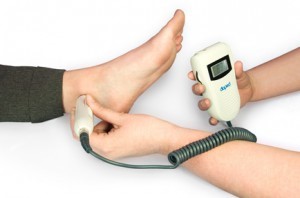Diabetic neuropathy is nerve damage in people with diabetes. Over time, elevated blood sugar levels destroy nerves in critical areas of the body in this susceptible population. Symptoms of diabetic neuropathy depend on which type you have, as there are several different types affecting different nerve areas of the body. With proper care and treatment, diabetes can be managed, and the life-threatening complications of diabetic neuropathy can be avoided.
Diabetic neuropathy is an umbrella diagnosis. Falling under this category are different versions, each posing nerve damage to different parts of the body. Those with diabetic neuropathy could have peripheral neuropathy, autonomic neuropathy, focal neuropathy or proximal neuropathy. Peripheral neuropathy is the most common in people with diabetes, estimated to affect up to half of those living with the disease. This nerve damage is to the legs and feet, and sometimes the upper extremities. In the feet especially, peripheral neuropathy is most prominent and often associated with peripheral vascular disease.
With peripheral neuropathy, there are many complications. Because nerves send messages to and from cells, muscles and external stimuli, when they are damaged from high blood sugar levels, loss of sensation in the feet and legs can occur. This means that extreme hot or cold temperatures cannot be felt if in contact with the foot, or any forms of sensation at all. In those with diabetic nerve pain in the feet, if injury occurs such as a cut or a large object is dropped on the area, a serious threat is posed because there is no feeling in the area and thus no response to injury. Nerve damage also implies that compromised areas of the feet will not heal well because blood flow is restricted. The biggest fear for people living with peripheral neuropathy is an injury to an extremity that cannot be felt or healed and has the capacity to negatively affect the rest of the body.
As well as nerve pain in the feet, sufferers of peripheral neuropathy also experience numbness and tingling in areas where their nerves are damaged. These conditions are notoriously worse at night, and can also include sharp pains, muscle weakness, extreme sensitivity and even ulcers and infections in the affected area. A highly potential outcome with peripheral neuropathy is the risk of amputating areas that are affected by damaged nerves. Untreated persons commonly lose their extremities.
Another implication of this condition is peripheral vascular disease. In persons with diabetes, blood vessels narrow due to buildup from high levels of glucose. The symptoms of this condition are similar to those of diabetic neuropathy, with narrowed blood vessels contributing to numbness, tingling, weakness and nerve pain in the feet. Peripheral vascular disease treatment includes lifestyle changes such as exercise and a healthy diet. When these aren’t enough, medications and surgery can help.
While diabetes is not always avoidable, the comorbidity of diabetic neuropathy and peripheral vascular disease is manageable and even preventable. Persons with diabetes are a susceptible population. Routine visits to a podiatrist are monumental in the monitoring and prevention of illnesses like peripheral neuropathy. A podiatrist can examine feet for loss of sensation that patients alone would not be able to recognise. Podiatrists also study the feet for any ulcers, deformities or signs of infection that can arise from nerve damage. Ingrown toenails are a high risk for infection and pain in people with damaged nerves; foot doctors can trim and prevent these nails from overgrowing. Peripheral vascular disease treatment and diabetic neuropathy treatment are essential. Keeping an eye on the health of a person’s feet with diabetes is another way to keep an eye on the progression of diabetes itself.
Because diabetic neuropathy has a direct correlation between nerve damage and ongoing elevated blood sugar levels, podiatry is a profession that specializes in the treatment of those living with the condition when nerve damage occurs in areas like the lower legs and feet. If you have nerve pain in your feet, maintaining routine visits to a foot doctor ensures you’re not only monitoring your foot health but the state and progression of your diabetes also. Proper maintenance provided by a podiatrist could save you time, pain, and even your feet from amputation.
Reach out to us to schedule your consultation today. For those living with diabetes, your precious feet need extra care and specialized treatment.

